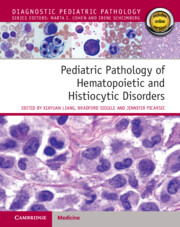Book contents
- Pediatric Pathology of Hematopoietic and Histiocytic Disorders
- Pediatric Pathology of Hematopoietic and Histiocytic Disorders
- Copyright page
- Epigraph
- Contents
- Contributors
- Section I General Hematology and Hematopathology
- Chapter 1 Development of Hematopoiesis in the Fetus, at Birth, and after Birth
- Chapter 2 Normal Anatomy and Function of Lymph Nodes
- Section II Non-Neoplastic Hematologic Disorders of Blood and Bone Marrow
- Section III Non-Neoplastic Disorders of Extramedullary Lymphoid Tissues
- Section IV Neoplastic Disorders of Bone Marrow
- Section V Mature Lymphoid Neoplasms
- Section VI Histiocytic Disorders and Neoplasms
- Index
- References
Chapter 1 - Development of Hematopoiesis in the Fetus, at Birth, and after Birth
from Section I - General Hematology and Hematopathology
Published online by Cambridge University Press: 25 January 2024
- Pediatric Pathology of Hematopoietic and Histiocytic Disorders
- Pediatric Pathology of Hematopoietic and Histiocytic Disorders
- Copyright page
- Epigraph
- Contents
- Contributors
- Section I General Hematology and Hematopathology
- Chapter 1 Development of Hematopoiesis in the Fetus, at Birth, and after Birth
- Chapter 2 Normal Anatomy and Function of Lymph Nodes
- Section II Non-Neoplastic Hematologic Disorders of Blood and Bone Marrow
- Section III Non-Neoplastic Disorders of Extramedullary Lymphoid Tissues
- Section IV Neoplastic Disorders of Bone Marrow
- Section V Mature Lymphoid Neoplasms
- Section VI Histiocytic Disorders and Neoplasms
- Index
- References
Summary
Hematopoiesis is a complex process encompassing the continuous generation of specialized, mature blood cells from pluripotent hematopoietic stem cells (HSCs). The hematopoietic system is not fully developed at birth. The proportion of bone marrow (BM) components and normal hematologic values for neonates, infants, older children, and adults are different as a result of the unique characteristics of embryonal and fetal development of the hematopoietic system, which continues to evolve after birth [1]. Knowledge of these differences is essential to distinguish normal development from a pathologic process when evaluating blood and BM in pediatric patients.
- Type
- Chapter
- Information
- Publisher: Cambridge University PressPrint publication year: 2024



